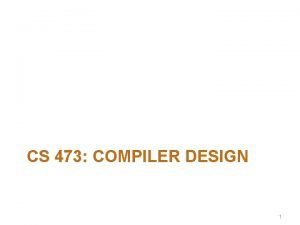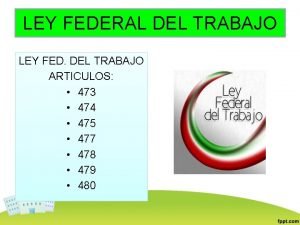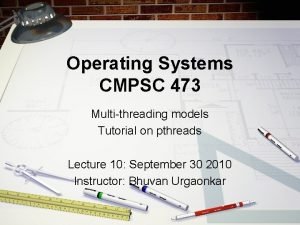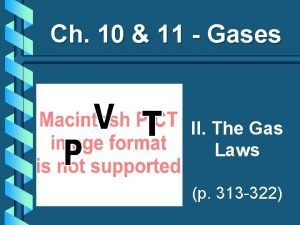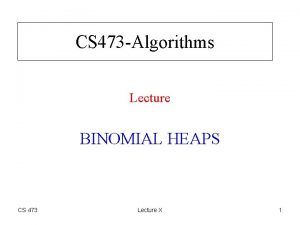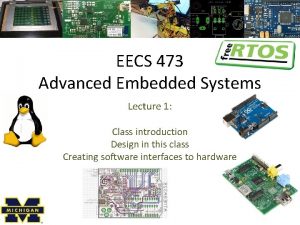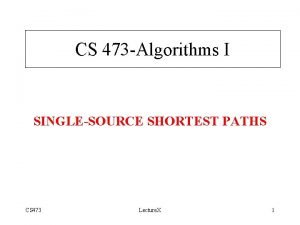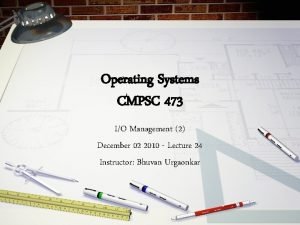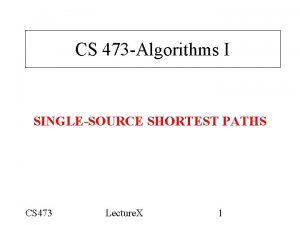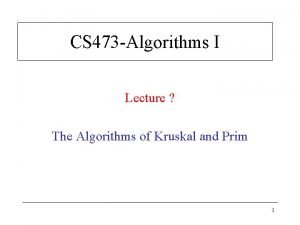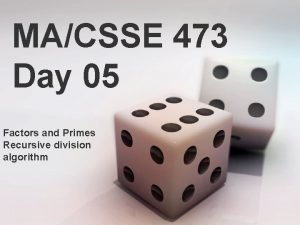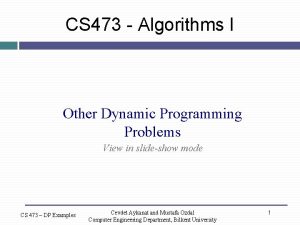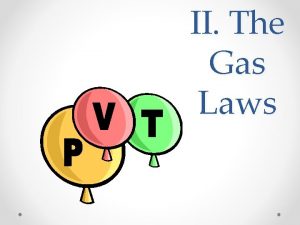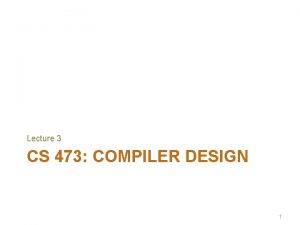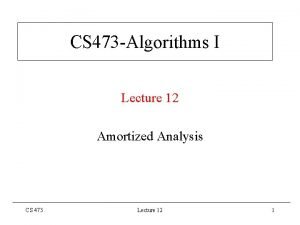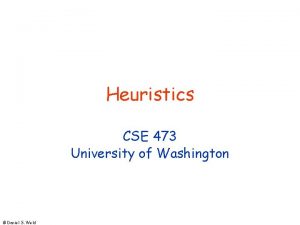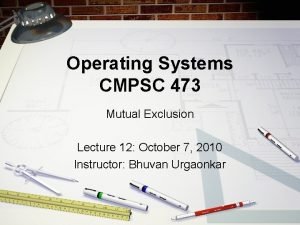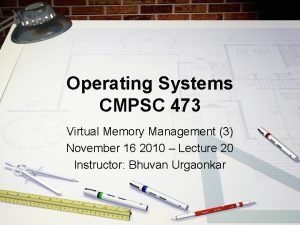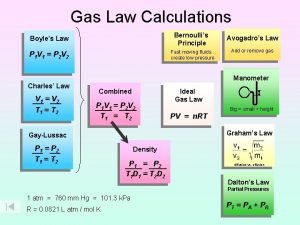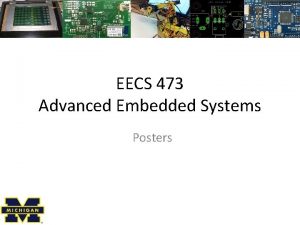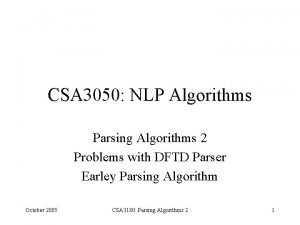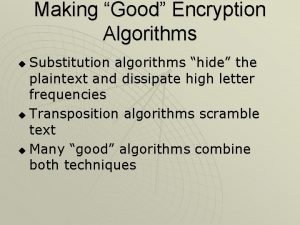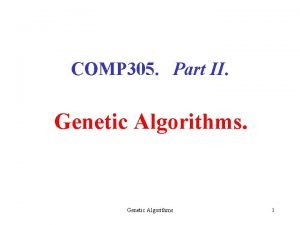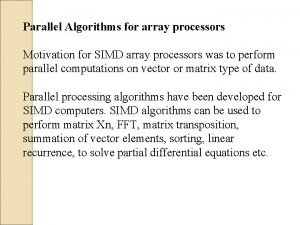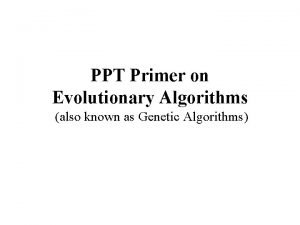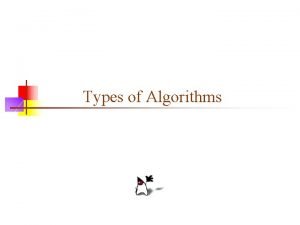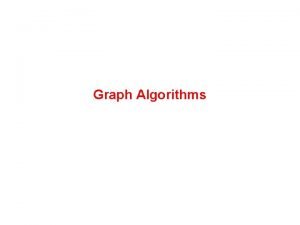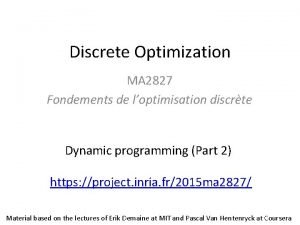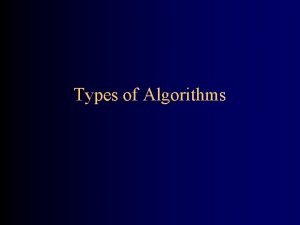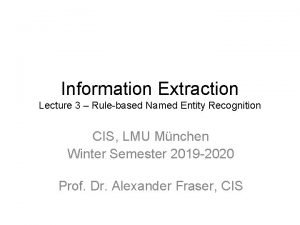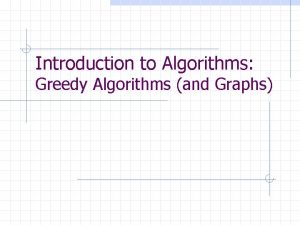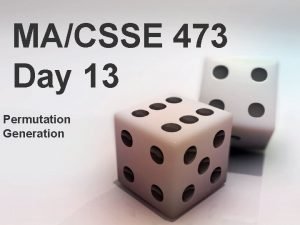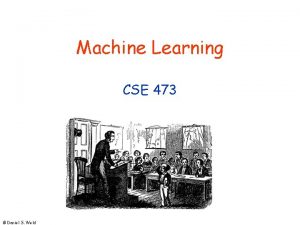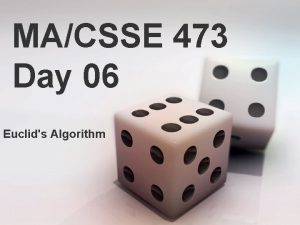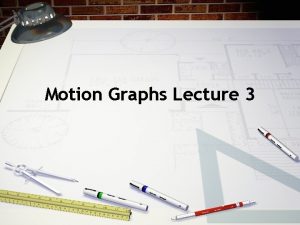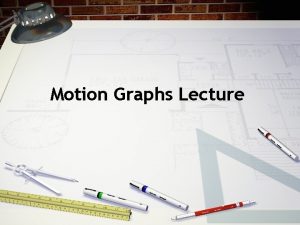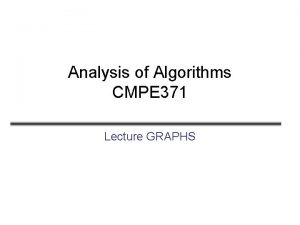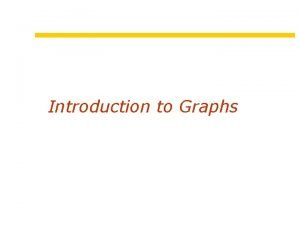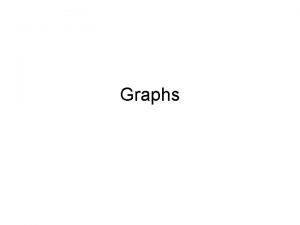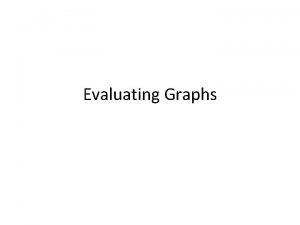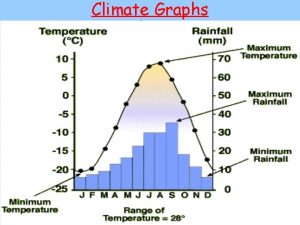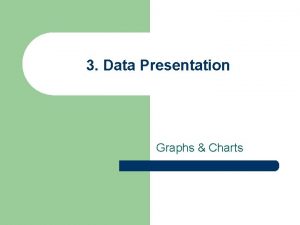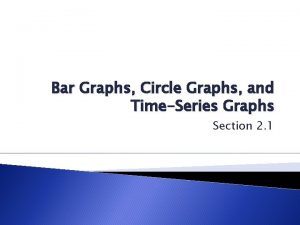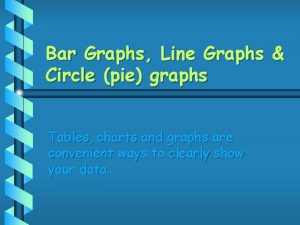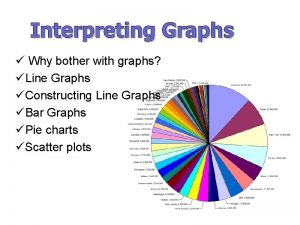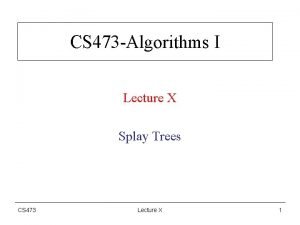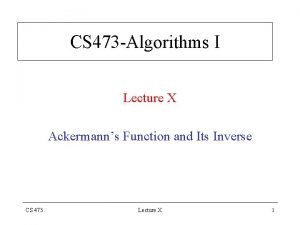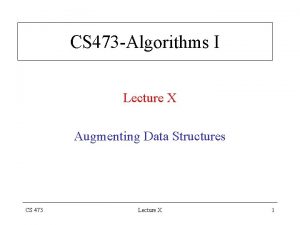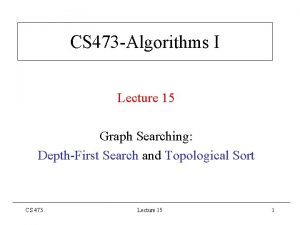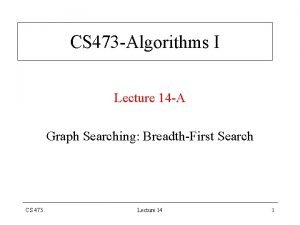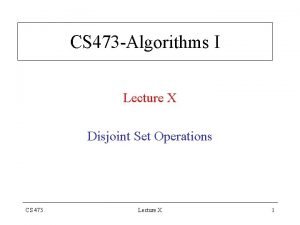CS 473 Algorithms I Lecture 13 A Graphs














































- Slides: 46

CS 473 -Algorithms I Lecture 13 -A Graphs CS 473 Lecture 13 1

Graphs A directed graph (or digraph) G is a pair (V, E), where V is a finite set, and E is a binary relation on V The set V: Vertex set of G The set E: Edge set of G Note that, self-loops -edges from a vertex to itself- are possible In an undirected graph G (V, E) • the edge set E consists of unordered pairs of vertices rather than ordered pairs, that is, (u, v) & (v, u) denote the same edge • self-loops are forbidden, so every edge consists of two distinct vertices CS 473 Lecture 13 2

Graphs Many definitions for directed and undirected graphs are the same although certain terms have slightly different meanings If (u, v) E in a directed graph G (V, E), we say that (u, v) is incident from or leaves vertex u and is incident to or enters vertex v If (u, v) E in an undirected graph G (V, E), we say that (u, v) is incident on vertices u and v If (u, v) is an edge in a graph G (V, E), we say that vertex v is adjacent to vertex u When the graph is undirected, the adjacency relation is symmetric When the graph is directed the adjacency relation is not necessarily symmetric if v is adjacent to u, we sometimes write u v CS 473 Lecture 13 3

Graphs The degree of a vertex in an undirected graph is the number of edges incident on it In a directed graph, out-degree of a vertex: number of edges leaving it in-degree of a vertex : number of edges entering it degree of a vertex : its in-degree its out-degree A path of length k from a vertex u to a vertex u in a graph G (V, E) is a sequence v 0, v 1, v 2, …, vk of vertices such that v 0 u, vk u and (vi 1, vi) E, for i 1, 2, …, k The length of a path is the number of edges in the path CS 473 Lecture 13 4

Graphs If there is a path p from u to u , we say that p u is reachable from u via p: u u A path is simple if all vertices in the path are distinct A subpath of path p v 0, v 1, v 2, …, vk is a contiguous subsequence of its vertices That is, for any 0 i j k, the subsequence of vertices vi 1, …, vj is a subpath of p vi, In a directed graph, a path v 0, v 1, …, vk forms a cycle if v 0 vk and the path contains at least one edge The cycle is simple if, in addition, v 0, v 1, …, vk are distinct A self-loop is a cycle of length 1 CS 473 Lecture 13 5

Graphs Two paths v 0, v 1, v 2, …, vk & v 0 , v 1 , v 2 , …, vk form the same cycle if there is an integer j such that vi v(i j) mod k for i 0, 1, …, k 1 The path p 1 1, 2, 4, 1 forms the same cycles as the paths p 2 2, 4, 1, 2 and p 3 4, 1, 2, 4 A directed graph with no self-loops is simple In an undirected graph a path v 0, v 1, …, vk forms a cycle if v 0 vk and v 1, v 2, …, vk are distinct A graph with no cycles is acyclic CS 473 Lecture 13 6

Graphs An undirected graph is connected if every pair of vertices is connected by a path The connected components of a graph are the equivalence classes of vertices under the “is reachable from” relation An undirected graph is connected if it has exactly one component, i. e. , if every vertex is reachable from every other vertex A directed graph is strongly-connected if every two vertices are reachable from each other The strongly-connected components of a digraph are the equivalence classes of vertices under the “are mutually reachable” relation A directed graph is strongly-connected if it has only one strongly-connected component CS 473 Lecture 13 7

Graphs Two graphs G (V, E) and G (V , E ) are isomorphic if there exists a bijection f : V V such that (u, v) E iff (f (u), f (v)) E That is, we can relabel the vertices of G to be vertices of G maintaining the corresponding edges in G and G G (V , E ) V {u, v, w, x, y, z} G (V, E) V {1, 2, 3, 4, 5, 6} Map from V V : f (1) u, f (2) v, f (3) w, f (4) x, f (5) y, f (6) z CS 473 Lecture 13 8

Graphs A graph G (V , E ) is a subgraph of G (V, E) if V V and E E Given a set V V, the subgraph of G induced by V is the graph G (V , E ) where E {(u, v) E: u, v V } G (V, E) CS 473 G (V , E ), the subgraph of G induced by the vertex set V {1, 2, 3, 6} Lecture 13 9

Graphs Given an undirected graph G (V, E), the directed version of G is the directed graph G (V , E ), where (u, v) E and (v, u) E (u, v) E That is, each undirected edge (u, v) in G is replaced in G by two directed edges (u, v) and (v, u) Given a directed graph G (V, E), the undirected version of G is the undirected graph G (V , E ), where (u, v) E u v and (u, v) E That is the undirected version contains the edges of G “with their directions removed” and with self-loops eliminated CS 473 Lecture 13 10

Graphs Note: G G i. e. , (u, v) and (v, u) in G are replaced in G by the same edge (u, v) In a directed graph G (V, E), a neighbor of a vertex u is any vertex that is adjacent to u in the undirected version of G That, is v is a neighbor of u iff either (u, v) E or (v, u) E v is a neighbor of u in both cases In an undirected graph, u and v are neighbors if they are adjacent CS 473 Lecture 13 11

Graphs Several kinds of graphs are given special names Complete graph: undirected graph in which every pair of vertices is adjacent Bipartite graph: undirected graph G (V, E) in which V can be partitioned into two disjoint sets V 1 and V 2 such that (u, v) E implies either u V 1 and v V 2 or u V 2 and v V 1 CS 473 Lecture 13 12

Graphs Forest: acyclic, undirected graph Tree: connected, acyclic, undirected graph Dag: directed acyclic graph Multigraph: undirected graph with multiple edges between vertices and self-loops Hypergraph: like an undirected graph, but each hyperedge, rather than connecting two vertices, connects an arbitrary subset of vertices h 1 (v 1, v 2) h 2 (v 2, v 5, v 6) h 3 (v 2, v 3, v 4, v 5) CS 473 Lecture 13 13

Free Trees • A free tree is a connected, acyclic, undirected graph • We often omit the adjective “free” when we say that a graph is a tree • If an undirected graph is acyclic but possibly disconnected it is a forest CS 473 Lecture 13 14

Theorem (Properties of Free Trees) The following are equivalent for an undirected graph G (V, E) 1. G is a free tree 2. Any two vertices in G are connected by a unique simple-path 3. G is connected, but if any edge is removed from E the resulting graph is disconnected 4. G is connected, and |E| |V| 1 5. G is acyclic, and |E| |V| 1 6. G is acyclic, but if any edge is added to E, the resulting graph contains a cycle CS 473 Lecture 13 15

Properties of Free Trees (1 2) (1) G is a free tree (2) Any two vertices in G are connected by a unique simple-path CS 473 Lecture 13 16

Properties of Free Trees (1 2) Since a tree is connected, any two vertices in G are connected by a simple path • Let two vertices u, v V are connected by two simple paths p 1 and p 2 • Let w and z be the first vertices at which p 1 and p 2 diverge and re-converge • Let p 1 be the subpath of p 1 from w to z • Let p 2 be the subpath of p 2 from w to z • p 1 and p 2 share no vertices except their end points • The path p 1 || p 2 is a cycle (contradiction) CS 473 Lecture 13 17

Properties of Free Trees (1 2) • p 1 and p 2 share no vertices except their end points • p 1 || p 2 is a cycle (contradiction) • Thus, if G is a tree, there can be at most one path between two vertices CS 473 Lecture 13 18

Properties of Free Trees (2 3) (2) Any two vertices in G are connected by a unique simple-path (3) G is connected, but if any edge is removed from E the resulting graph is disconnected CS 473 Lecture 13 19

Properties of Free Trees (2 3) If any two vertices in G are connected by a unique simple path, then G is connected • Let (u, v) be any edge in E. This edge is a path from u to v. So it must be the unique path from u to v • Thus, if we remove (u, v) from G, there is no path from u to v • Hence, its removal disconnects G CS 473 Lecture 13 20

Properties of Free Trees (3 4) Before proving 3 4 consider the following Lemma: any connected, undirected graph G (V, E) satisfies |E| |V| 1 Proof: Consider a graph G with |V| vertices and no edges. Thus initially there are |C| |V| connected components – Each isolated vertex is a connected component Consider an edge (u, v) and let Cu and Cv denote the connected-components of u and v CS 473 Lecture 13 21

Properties of Free Trees (Lemma) If Cu Cv then (u, v) connects Cu and Cv into a connected component Cuv Otherwise (u, v) adds an extra edge to the connected component Cu Cv Hence, each edge added to the graph reduces the number of connected components by at most 1 Thus, at least |V| 1 edges are required to reduce the number of components to 1 Q. E. D CS 473 Lecture 13 22

Properties of Free Trees (3 4) (3) G is connected, but if any edge is removed from E the resulting graph is disconnected (4) G is connected, and |E| |V| 1 CS 473 Lecture 13 23

Properties of Free Trees (3 4) By assuming (3), the graph G is connected We need to show both |E| |V| 1 and |E| |V| 1 in order to show that |E| |V| 1: valid due previous lemma |E| |V| 1: (proof by induction) Basis: a connected graph with n 1 or n 2 vertices has n 1 edges IH: suppose that all graphs G (V , E ) satisfying (3) also satisfy |E | |V | 1 CS 473 Lecture 13 24

Properties of Free Trees (3 4) Consider G (V, E) that satisfies (3) with |V| n 3 Removing an arbitrary edge (u, v) from G separates the graph into 2 connected graphs Gu (Vu, Eu) and Gv (Vv, Ev) such that V Vu Vv and E Eu Ev Hence, connected graphs Gu and Gv both satisfy (3) else G would not satisfy (3) Note that |Vu| and |Vv| n since |Vu| |Vv| n Hence, |Eu| |Vu| 1 and |Ev| |Vv| 1 (by IH) Thus, |E| |Eu| |Ev| 1 (|Vu| 1) (|Vv| 1) 1 |E| |V| 1 Q. E. D CS 473 Lecture 13 25

Properties of Free Trees (4 5) (4) G is connected, and |E| |V| 1 (5) G is acyclic, and |E| |V| 1 CS 473 Lecture 13 26

Properties of Free Trees (4 5) Suppose that G is connected, and |E| |V| 1, we must show that G is acyclic • Suppose G has a cycle containing k vertices v 1, v 2, , vk • Let Gk (Vk, Ek) be subgraph of G consisting of the cycle Note: |Vk| |Ek| k If k |V|, there must be a vertex vk 1 V Vk that is adjacent to some vertex vi Vk, since G is connected CS 473 Lecture 13 27

Properties of Free Trees (4 5) Define Gk 1 (Vk 1, Ek 1) to be subgraph of G with Vk 1 Vk vk 1 and Ek 1 Ek (vk 1, vi) Note: |Vk 1| |Ek 1| If k 1 |V|, we can similarly define Gk 2 (Vk 2, Ek 2) to be the subgraph of G with Vk 2 Vk 1 vk 2 and Ek 2 Ek 1 (vk 2, vj) for some vj Vk 1 where |Vk 2| |Ek 2| CS 473 Lecture 13 28

Properties of Free Trees (4 5) We can continue defining Gk mwith |Vk m| |Ek m| until we obtain Gn (Vn, En) where n |V| and Vn |V| and |Vn| |En| |V| • Since Gn is a subgraph of G, we have En E |E| |En| |V| which contradicts the assumption |E| |V| 1 Hence G is acyclic Q. E. D CS 473 Lecture 13 29

Properties of Free Trees (5 6) (5) G is acyclic, and |E| |V| 1 (6) G is acyclic, but if any edge is added to E, the resulting graph contains a cycle CS 473 Lecture 13 30

Properties of Free Trees (5 6) Suppose that G is acyclic and |E| |V| 1 • Let k be the number of connected components of G G 1 (V 1, E 1), G 2 (V 2, E 2), , Gk (Vk, Ek) such that k Vi V; i =1 k Ei E; i =1 Vi Vj ; 1 i, j k and i j Ei Ej ; 1 i, j k and i j Each connected component Gi is a tree by definition CS 473 Lecture 13 31

Properties of Free Trees (5 6) Since (1 5) each component Gi is satisfies |Ei| |Vi| 1 for i =1, 2, , k • Thus k k k i =1 | E i | | Vi | 1 | E | | V| k • Therefore, we must have k =1 CS 473 Lecture 13 32

Properties of Free Trees (5 6) That is (5) G is connected G is a tree Since (1 2) any two vertices in G are connected by a unique simple path Thus, adding any edge to G creates a cycle CS 473 Lecture 13 33

Properties of Free Trees (6 1) (6) G is acyclic, but if any edge is added to E, the resulting graph contains a cycle (1) G is a free tree CS 473 Lecture 13 34

Properties of Free Trees (6 1) Suppose that G is acyclic but if any edge is added to E a cycle is created We must show that G is connected due to the definition Let u and v be two arbitrary vertices in G If u and v are not already adjacent adding the edge (u, v) creates a cycle in which all edges but (u, v) belong to G CS 473 Lecture 13 35

Properties of Free Trees (6 1) Thus there is a path from u to v, and since u and v are chosen arbitrarily G is connected CS 473 Lecture 13 36

Representations of Graphs • The standard two ways to represent a graph G (V, E) – As a collection of adjacency-lists – As an adjacency-matrix • Adjacency-list representation is usually preferred – Provides a compact way to represent sparse graphs • Those graphs for which | E | | V |2 CS 473 Lecture 13 37

Representations of Graphs • Adjacency-matrix representation may be preferred – for dense graphs for which |E| is close to |V|2 – when we need to be able to tell quickly if there is an edge connecting two given vertices CS 473 Lecture 13 38

Adjacency-List Representation • An array Adj of |V| lists, one for each vertex u V • For each u V the adjacency-list Adj[u] contains (pointers to) all vertices v such that (u, v) E • That is, Adj[u] consists of all vertices adjacent to u in G • The vertices in each adjacency-list are stored in an arbitrary order CS 473 Lecture 13 39

Adjacency-List Representation • If G is a directed graph – The sum of the lengths of the adjacency lists | E | • If G is an undirected graph – The sum of the lengths of the adjacency lists 2| E | since an edge (u, v) appears in both Adj[u] and Adj[v] CS 473 Lecture 13 40

Representations of Graphs Undirected Graphs CS 473 Lecture 13 41

Representations of Graphs Directed Graphs CS 473 Lecture 13 42

Adjacency List Representation (continued) Adjacency list representation has the desirable property it requires O(max(V, E)) O(V E) memory for both undirected and directed graphs Adjacency lists can be adopted to represent weighted graphs each edge has an associated weight typically given by a weight function w: E R The weight w(u, v) of an edge (u, v) E is simply stored with vertex v in Adj[u] or with vertex u in Adj[v] or both CS 473 Lecture 13 43

Adjacency List Representation (continued) A potential disadvantage of adjacency list representation there is no quicker way to determine if a given edge (u, v) is present in G than to search v in Adj[u] or u in Adj[v] This disadvantage can be remedied by an adjacency matrix representation at the cost of using asymptotically more memory CS 473 Lecture 13 44

Adjacency Matrix Representation Assume that, the vertices of G (V, E) are numbered as 1, 2, …, |V| Adjacency matrix rep. consists of a |V| matrix A=(aij) Requires (V 2) memory independent of the number of edges |E| We define the transpose of a matrix A (aij) to be the matrix AT (aij)T given by aij. T aji Since in an undirected graph, (u, v) and (v, u) represent the same edge A AT for an undirected graph That is, adjacency matrix of an undirected graph is symmetric Hence, in some applications, only upper triangular part is stored CS 473 Lecture 13 45

Adjacency Matrix Representation Adjacency matrix representation can also be used for weighted graphs Adjacency matrix may also be preferable for reasonably small graphs Moreover, if the graph is unweighted rather than using one word of memory for each matrix entry adjacency matrix representation uses one bit per entry CS 473 Lecture 13 46
 Introduction to algorithms lecture notes
Introduction to algorithms lecture notes Analysis of algorithms lecture notes
Analysis of algorithms lecture notes Graphs that enlighten and graphs that deceive
Graphs that enlighten and graphs that deceive 5-3 practice polynomial functions
5-3 practice polynomial functions Zczc state graph
Zczc state graph Speed and velocity
Speed and velocity 01:640:244 lecture notes - lecture 15: plat, idah, farad
01:640:244 lecture notes - lecture 15: plat, idah, farad Eecs 473
Eecs 473 Single static assignment
Single static assignment Cmpsc 473
Cmpsc 473 Articulo 474
Articulo 474 Cmpsc 473
Cmpsc 473 A gas occupies 473 cm3 at 36°c. find its volume at 94°c
A gas occupies 473 cm3 at 36°c. find its volume at 94°c A gas occupies 473 cm3 at 36°c. find its volume at 94°c
A gas occupies 473 cm3 at 36°c. find its volume at 94°c Cs 473
Cs 473 Eecs 473
Eecs 473 Cs 473
Cs 473 Cmpsc 473
Cmpsc 473 Cs 473
Cs 473 Eecs 473
Eecs 473 Round 333 to the nearest ten
Round 333 to the nearest ten Cs 473
Cs 473 Factors of 473
Factors of 473 A gas occupies 473 cm3 at 36°c. find its volume at 94°c
A gas occupies 473 cm3 at 36°c. find its volume at 94°c Bilkent cs473
Bilkent cs473 Boyle's law k
Boyle's law k Cs 473
Cs 473 Cs 473
Cs 473 Uw cse 473
Uw cse 473 Cmpsc 473
Cmpsc 473 Cmpsc 473
Cmpsc 473 Boyle's gas law formula
Boyle's gas law formula Pv k
Pv k Embedded systems poster
Embedded systems poster Advanced search algorithms
Advanced search algorithms Data structures and algorithms
Data structures and algorithms Parsing algorithms in nlp
Parsing algorithms in nlp Making good encryption algorithms
Making good encryption algorithms Genetic algorithms
Genetic algorithms Simd parallel algorithms
Simd parallel algorithms Evolution of logistics ppt
Evolution of logistics ppt Algorithms types
Algorithms types Analysis of algorithms
Analysis of algorithms Undirected graph algorithms
Undirected graph algorithms Discrte
Discrte Types of algorithms
Types of algorithms Information extraction algorithms
Information extraction algorithms








